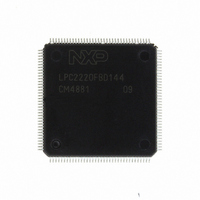LPC2220FBD144,551 NXP Semiconductors, LPC2220FBD144,551 Datasheet - Page 30

LPC2220FBD144,551
Manufacturer Part Number
LPC2220FBD144,551
Description
IC ARM7 MCU RAM 64K 144-LQFP
Manufacturer
NXP Semiconductors
Series
LPC2200r
Datasheet
1.LPC2210FBD144015.pdf
(50 pages)
Specifications of LPC2220FBD144,551
Program Memory Type
ROMless
Package / Case
144-LQFP
Core Processor
ARM7
Core Size
16/32-Bit
Speed
75MHz
Connectivity
EBI/EMI, I²C, Microwire, SPI, SSI, SSP, UART/USART
Peripherals
POR, PWM, WDT
Number Of I /o
76
Ram Size
64K x 8
Voltage - Supply (vcc/vdd)
1.65 V ~ 3.6 V
Data Converters
A/D 8x10b
Oscillator Type
Internal
Operating Temperature
-40°C ~ 85°C
Processor Series
LPC22
Core
ARM7TDMI-S
Data Bus Width
16 bit, 32 bit
Data Ram Size
64 KB
Interface Type
I2C/SPI/SSP/UART
Maximum Clock Frequency
75 MHz
Number Of Programmable I/os
76
Number Of Timers
2
Operating Supply Voltage
1.8 V
Maximum Operating Temperature
+ 85 C
Mounting Style
SMD/SMT
3rd Party Development Tools
MDK-ARM, RL-ARM, ULINK2
Development Tools By Supplier
OM10091
Minimum Operating Temperature
- 40 C
On-chip Adc
8-ch x 10-bit
Package
144LQFP
Device Core
ARM7TDMI-S
Family Name
LPC2000
Maximum Speed
75 MHz
Lead Free Status / RoHS Status
Lead free / RoHS Compliant
For Use With
OM10091 - KIT DEV PHYCORE-ARM7/LPC2220622-1005 - USB IN-CIRCUIT PROG ARM7 LPC2K568-1757 - BOARD EVAL FOR LPC220X ARM MCU
Eeprom Size
-
Program Memory Size
-
Lead Free Status / Rohs Status
Lead free / RoHS Compliant
Other names
568-1896
935278829551
LPC2220FBD144-S
935278829551
LPC2220FBD144-S
Available stocks
Company
Part Number
Manufacturer
Quantity
Price
Company:
Part Number:
LPC2220FBD144,551
Manufacturer:
Microchip
Quantity:
150
Company:
Part Number:
LPC2220FBD144,551
Manufacturer:
NXP Semiconductors
Quantity:
10 000
Part Number:
LPC2220FBD144,551
Manufacturer:
NXP/恩智浦
Quantity:
20 000
NXP Semiconductors
LPC2210_2220_6
Product data sheet
6.20.5 Memory mapping control
6.20.6 Power control
6.20.7 APB
6.21 Emulation and debugging
The memory mapping control alters the mapping of the interrupt vectors that appear
beginning at address 0x0000 0000. Vectors may be mapped to the bottom of the BANK0
external memory, or to the on-chip static RAM. This allows code running in different
memory spaces to have control of the interrupts.
The LPC2210/2220 support two reduced power modes: Idle mode and Power-down
mode.
In Idle mode, execution of instructions is suspended until either a reset or interrupt occurs.
Peripheral functions continue operation during Idle mode and may generate interrupts to
cause the processor to resume execution. Idle mode eliminates power used by the
processor itself, memory systems and related controllers, and internal buses.
In Power-down mode, the oscillator is shut down, and the chip receives no internal clocks.
The processor state and registers, peripheral registers, and internal SRAM values are
preserved throughout Power-down mode, and the logic levels of chip output pins remain
static. The Power-down mode can be terminated and normal operation resumed by either
a reset or certain specific interrupts that are able to function without clocks. Since all
dynamic operation of the chip is suspended, Power-down mode reduces chip power
consumption to nearly zero.
A power control for peripherals feature allows individual peripherals to be turned off if they
are not needed in the application, resulting in additional power savings.
The APB divider determines the relationship between the processor clock (CCLK) and the
clock used by peripheral devices (PCLK). The APB divider serves two purposes. The first
is to provide peripherals with the desired PCLK via APB so that they can operate at the
speed chosen for the ARM processor. In order to achieve this, the APB may be slowed
down to
power-up (and its timing cannot be altered if it does not work since the APB divider control
registers reside on the APB), the default condition at reset is for the APB to run at
processor clock rate. The second purpose of the APB divider is to allow power savings
when an application does not require any peripherals to run at the full processor rate.
Because the APB divider is connected to the PLL output, the PLL remains active (if it was
running) during Idle mode.
The LPC2210/2220 support emulation and debugging via a JTAG serial port. A trace port
allows tracing program execution. Debugging and trace functions are multiplexed only with
GPIOs on Port 1. This means that all communication, timer and interface peripherals
residing on Port 0 are available during the development and debugging phase as they are
when the application is run in the embedded system itself.
1
2
to
1
4
of the processor clock rate. Because the APB must work properly at
Rev. 06 — 11 December 2008
16/32-bit ARM microcontrollers
LPC2210/2220
© NXP B.V. 2008. All rights reserved.
1
4
30 of 50
of the
















